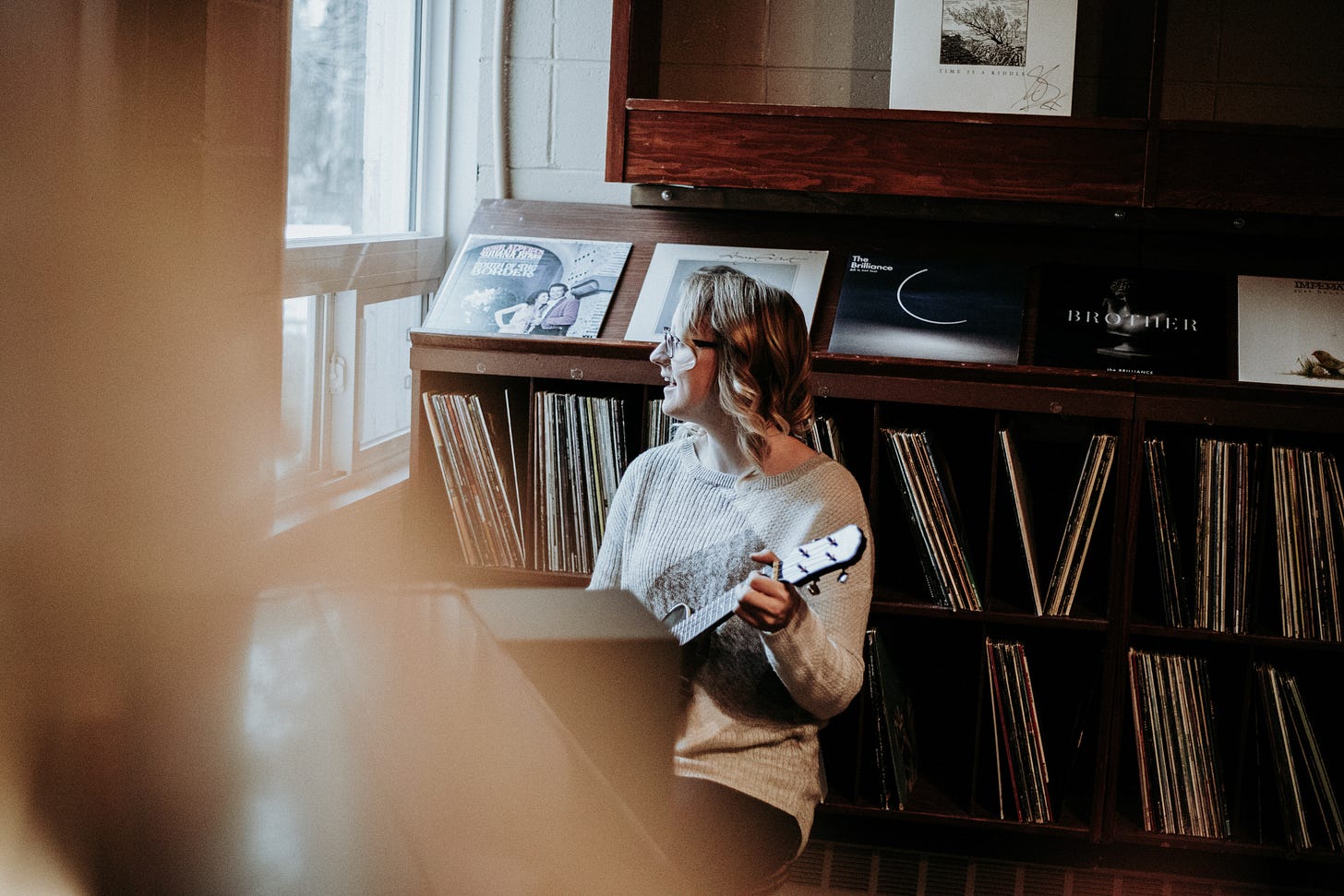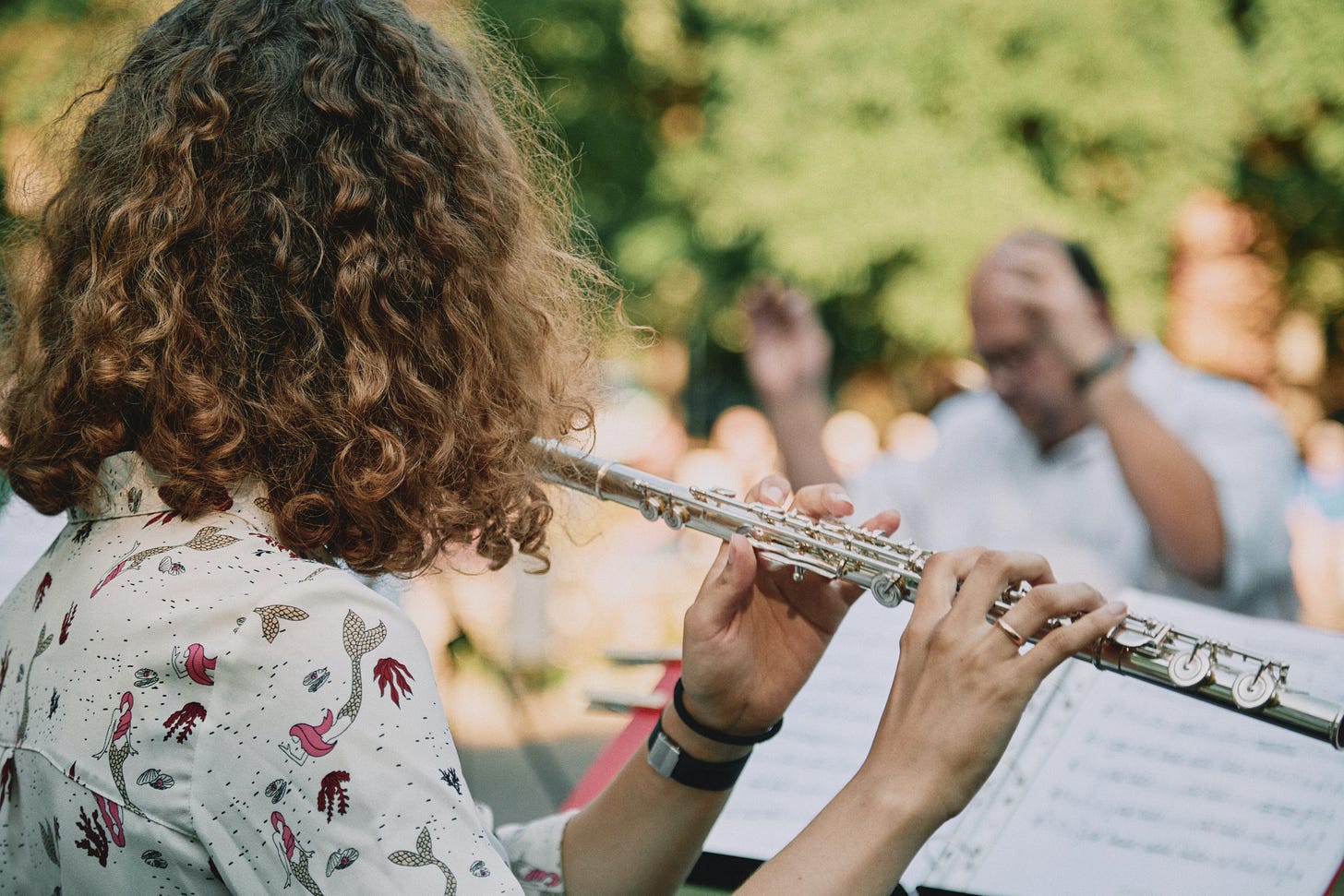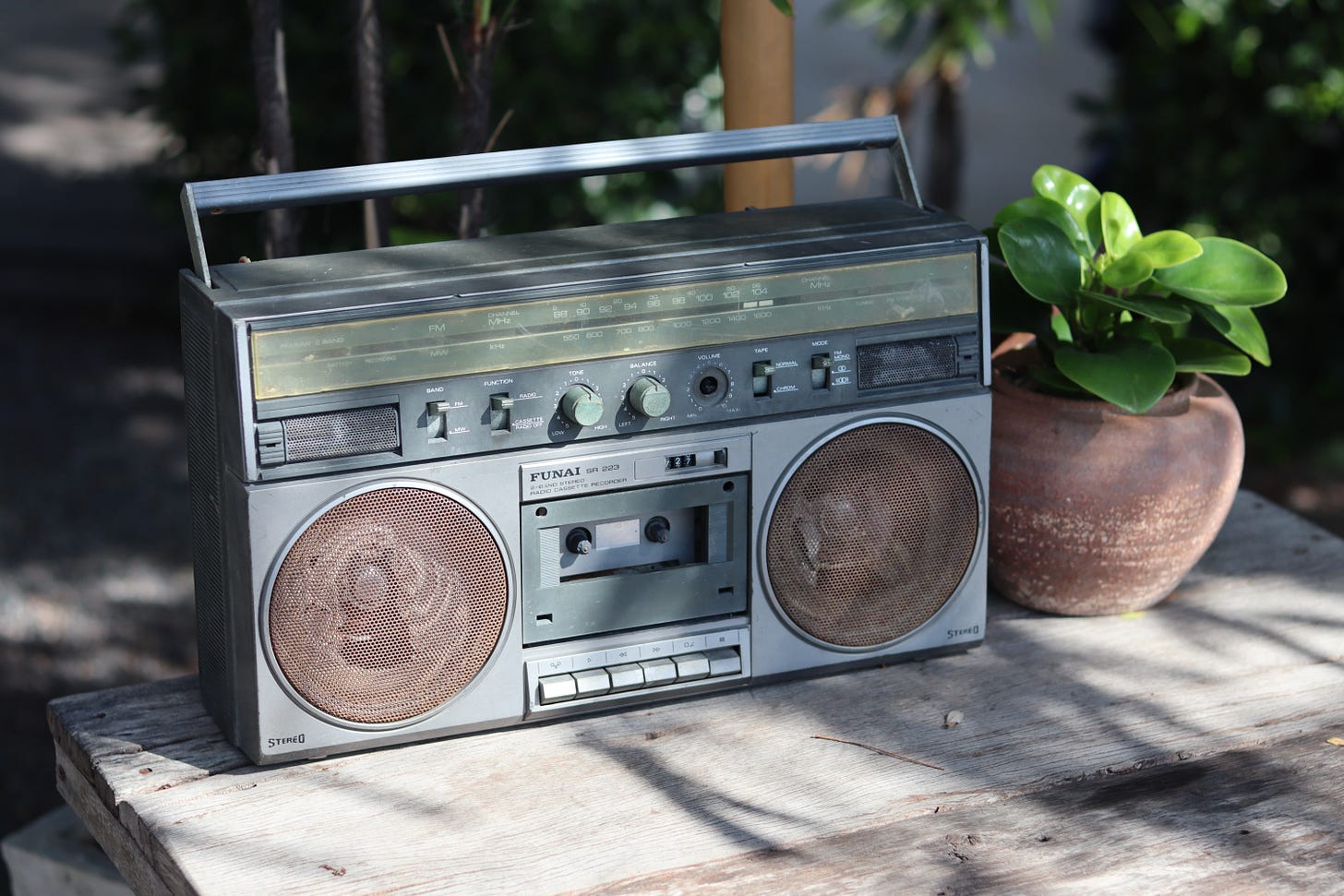Do you play an instrument? Sing in a choir? Crank your favorite tunes when you’re cleaning the house? Study after study shows that music can help us process the entire spectrum of our emotions, support healing, strengthen our memory, improve our sleep (unless we’re listening to scream-o heavy metal, perhaps!), increase our motivation, and reduce stress. Music can center us, connect us with others, and be one way in which we can worship God.
My friend Meg discovered when she was in her fifties that she loved going to memory care units and assisted living centers in order to lead sing-a-longs of hymns and old popular favorites. Watching the residents come alive as they listen and participate has changed the direction of Meg’s life. She now performs reguarly at several care facilities. Music has formed her later-in-life vocation in ways she never would have imagined the first time she ventured into a memory care unit with her guitar nearly twenty years ago.
Whether you sing in the shower or perform in front of an audience, we hope the two reflections (below) in this month’s newsletter can inspire you to tap into music’s benefits in your life as you step into 2024. This month’s newsletter also includes media picks, a couple of cool invitations, and more.
Let’s make some good noise this year, Sages!
Michelle Van Loon, on behalf of the entire Sage Forum team
The Gift of Music
by Sharla Fritz
Music is one of the fairest and most glorious gifts of God, to which Satan is a bitter enemy; for it removes from the heart the weight of sorrow and the fascination of evil thoughts. —Martin Luther
I have appreciated the gift of music ever since I started piano lessons at age 5. As I grew, so did my love for music—largely because of the influence of inspiring teachers. Eventually, my passion for music turned into my vocation as a piano teacher and church musician. I wholeheartedly agree with Martin Luther that music is a glorious gift of God.
All of us may benefit by adding more music to our sage years. I have found that hearing a Christian song on the radio can retune my heart to Christ. When I hear the sound of joyful praise to an awesome God, He removes the weight of sorrow from my heart. When I sing gospel-rich hymns, Satan flees. When the record in my mind seems to be stuck in a depressing groove, engaging in a favorite song rooted in God’s Word can change the track in my mind to one of gratitude.
Maybe it’s time to refresh your relationship with music. Here are a few strategies to add more music to your life:
Consider returning to the instrument you played in high school. (See Carole’s story below for more on this topic.) Get it out of the closet. Take it to the instrument repair shop.
Join a choir. If you love singing, join your church choir or praise team. Or find a community choir. Not only will you add the richness of music, but you will most likely form new connections with people.
Take lessons. You might take lessons to relearn your instrument or improve your singing. But even if you never played or sang before, it is never too late to start. Right now I have three adult piano students who all agree that sitting down at the piano is one of their great joys in life. Two of them started out as beginners when they came to me. Now, a few years later, they are playing easy classical pieces and beautiful arrangements of popular songs.
Fit in more time to listen to music. Listen to uplifting music in the car, when you get dressed in the morning, or when doing physical tasks like cooking or cleaning.
Attend concerts and recitals. Find out when live music is happening in your city. Ask a friend to go along with you.
Create a playlist on Spotify or other streaming service. Find songs that draw your heart closer to God and put them on a playlist that you can listen to whenever you find yourself feeling low or sense your heart pulling away from God.
What would you add to this list? Please share in the comments section below!
Making Joyful Noises
By Carole Duff
Six years ago, I was sitting in church and listening to a fellow member accompany the choir on her flute. Though I’d been a music minor in college and played a solo recital in my senior year, I hadn’t touched my flute in over thirty years and hadn’t performed in public for nearly forty. Raising children while teaching high school students full time meant somethings had to give, and one was music performance, both playing flute and singing in the university choir.
Yet my life remained rich with music. My children took piano lessons, danced, and sang in choirs through their growing-up years. I drove carpool, baked cookies for recitals, sat in the audience, and applauded. But that day in church as I heard the joyful noises of my fellow flutist—she had also not played in many years—I knew it was time to fish or cut bait: play the beautiful solid silver, hand-crafted Haynes flute I’d purchased while in college or sell it.
I took my flute to the music shop in town and contracted with them to repair the ravages of time and my neglect: to re-pad the keys and restore the mechanics. More importantly, my decision to play again reflected the change of heart I’d experienced during those many years away from music performance. In this third chapter of life, the harvest time, I would no longer play for myself but for the glory of God.
In 2009, Sarah Lawrence-Lightfoot, Professor of Sociology at Harvard’s Graduate School of Education, published a book titled The Third Chapter: Passion, Risk, and Adventure in the 25 Years After 50. Through interviews with a broad spectrum of people over 50, Lawrence-Lightfoot captured the essence of this creative period of life, when many explore new enthusiasms, reconnect with former passions, and channel their energies in new ways. The third chapter can be a time of transformative and generative reinvention, marked by the wisdom of experience, learning, and growth.
"We must develop a compelling vision of later life,” Lawrence-Lightfoot wrote, “one that does not assume a trajectory of decline after fifty, but one that recognizes it as a time of change, growth, and new learning; a time when ‘our courage gives us hope.'" Some third-chapter people she interviewed went back to school and started new careers. Others rekindled past interests, such as community gardening or social service, while still others explored another side of their wage-earning professions: a welder became a metal sculptor.
After retiring from over thirty years of teaching, I launched a new career in writing while rekindling my passion for music. Writing proved to be a slow, ongoing learning process, and, unlike riding a bike again after many years, so did relearning to play my flute.
With grit, hope, and determination, I picked up my flute from the shop, attached the foot joint, body, and head joint, sighted down the barrel to line up the keys with the center of the mouthpiece, placed my lower lip against the embouchure hole, and blew. Not much sound emerged, and what did was not a joyful noise. I had to wake up long unused muscles and relearn lost fingerings. What needed the most work was my embouchure and breath control.
To understand how important this is, here’s a little lesson about wind-instrument, “joyful noise” harmonics. A flutist can vary pitch, without altering fingering, by modifying intensity of breath and embouchure. Slow downward breaths with relaxed lips produce the first octave’s natural harmonics between middle C and the C above. Second octave pitches have the same fingerings as the first, but embouchure tightens and breath “overblows.” For the third octave, the flutist overblows and uses different fingerings. Both second and third octaves are harmonics that exclude the fundamental tone and some lower overtones, but if played well, sound like fundamentals—round and full.
It took weeks of daily practice to wake up the muscles in my mouth, diaphragm, and fingers in order to play even the simplest pieces without squawks. Persistence paid off. After a few months, I played a duet in church with the other flutist. But, with so much playing, my college flute soon needed further adjustments. Because I didn’t want to lose ground while it was in the shop, I purchased a second C-foot Haynes, this flute with a drop-G to better accommodate the arthritis in my ring finger, and a gold riser, also called the wall or chimney, the part of the flute where the lip piece is soldered to the head joint. Compared to my college flute’s light, sweet colors, the new flute’s hues were rich and soulful.
I’d always had nice tone but never enough dexterity to be a professional, and I didn’t think age had improved my agility. So far, that’s proven to be the case. But, as my husband says, if God wants me to play Flight of the Bumblebee then I’ll play Flight of the Bumblebee. Now I practice both flutes every day and play the new flute, with a microphone attached to the head piece, when practicing and performing with the worship team at church. All for His glory.
Which goes to show you, it’s never too late to make a joyful noise unto the Lord.
As an epilogue to my return to music, I now sing in the choir, too. Initially, my voice rasped and broke. But with practice, perseverance, and the breath control I’d gained from flute-playing, my ability to sing came back. Not the youthful, wannabe soprano voice I used to have, but a deep, resonant, third-chapter alto, singing and serving the Lord with gladness.
Have you revived an old musical skill – or decided to try something new in your own sage years? If so, tell us about it in the comments below.
Additional reads about the benefits of music in our lives:
Modern hymn writer Keith Getty talks about music, spiritual formation, Christmas carols, and more
Keep Your Brain Young With Music
Why Does The Music We Heard As Teens Stick?
Music and Trauma: Where Words Fail, Music Speaks
January Media Picks From Our Sage Forum Team
[VIDEO-Netflix] Fisk – After her marriage implodes, a lawyer joins a low-rent estate and will planning firm. The dry, occasionally off-color humor of this Australian comedy series will appeal to fans of workplace comedies like 30 Rock or The Office. (MV)
[BOOK] Life Reimagined: The Science, Art, and Opportunity of Midlife by Barbara Bradley Hagerty. Those who reach the second half of life, seeing the finish line in the distance, ask, “What now?” Barbara Bradley Hagerty offers sage answers: engage in relationships (what you do is not who you are), choose purpose (meaning trumps pleasure), and think—since thoughts and attitudes guide your future, embrace novelty and optimism, even when bad things happen. Choose what you love; invest time both long-term and outward; face your fear and become who you were meant to be. One of the best reads for mid-lifers. (CD)
[VIDEO-Prime] The Man Who Invented Christmas. This movie gives an imaginative glimpse into the back story of Charles Dickens writing A Christmas Carol. (SF)
[BOOK] How to Know a Person: The Art of Seeing Others Deeply and Being Deeply Seen by David Brooks. This engaging read offers readers a thoughtful look at how we can build meaningful relationships in the midst of a culture plagued by loneliness and isolation. (MV)
[VIDEO-Hulu] A Small Light. A limited series telling the story of Anne Frank from the point of view of Miep, who worked as a secretary for Otto Frank before the family went into hiding and daily helped them while they were hiding. (SF)
What are you reading, watching, or listening to this month?
Team Sage, Unite!
We grow better together, right? As we step into a new year, we are looking to hear about how you’re finding community that is helping you and others grow in wisdom, faith, and love:
Are you in an intergenerational ministry at church?
Are you a part of a sisterhood of sage women (a book club, a Bible study, a group focused on spiritual practices) in your congregation or community?
If the answer to either of those questions is yes, we’d love to hear more about what you’re doing. Click here to email us in order to share your experience.
We know it isn’t always easy to find this kind of community. If you’d be interested in participating in a six month long cohort who would meet monthly via Zoom to discuss topics relevant to those of us in our Sage years (click here to look at the Table of Contents in the book that started it all; these would be the starting point for our conversations) Click here to let us know if you’re interested in exploring this further.
Upcoming
Are you thinking about attending the HopeWords Writer’s Conference April 12th-13th in Bluefield, WV? (Click here to learn more about this event.) We’re hosting a special gathering for our friends the morning of April 12th before HopeWords kicks off later that afternoon! Click here to contact us if you’d like to be added to our list for more information about our gathering.
Next month: Our BOOKS issue! What are you reading? What books have formed you?
Visit or subscribe to our YouTube channel for half-hour discussions about topics of interest to women in the second half of life.
Finally, a prayer for your new year (author unknown):
Dear Lord, please give me...
A few friends who understand me and remain my friends; a work to do which has real value, without which the world would be the poorer;
A mind unafraid to travel, even though the trail be not blazed;
An understanding heart;
A sense of humor;
Time for quiet, silent meditation;
Your presence.
The patience to wait for the coming of these things,
With the wisdom to recognize them when they come. Amen.
Photos by Junior Gabriel, Joonas Sild, Priscilla Du Preez on Unsplash.







I would add: take up square dancing! Music, movement, lots of smile, plus hand-over-hand physical contact, which can be very limited for those living alone. Plus, if you’re old enough for Medicare Advantage, your class and dance fees are probably reimbursable as “fitness” activities!
Delighted to be here, as Sage, to continue my belief in life-long learning. Music becoming high priority as I begin to understand deeper layers, significance of music in our lives, from various sources. I first learned this from Edith Schaeffer many years ago with her book 'The Gift of Music'.